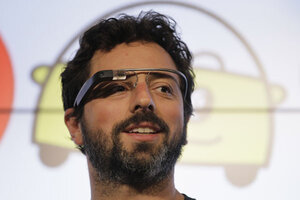Google Glass guidelines: No ads, for now. No charging money, for now.
Google lays out privacy guidelines to protect Google Glass users.

Google cofounder Sergey Brin wears a pair of Google Glass. Google could be developing a Google Glass concept store in the San Francisco Bay.
Eric Risberg/AP/File
Google Glass guidelines for software developers were released this week, and the first prototype glasses have been shipping to developers and “Glass Explorers” in batches as they are produced. Those receiving early-access Glass have paid $1,500 for the privilege of field testing.
Along with the shipment, which some users can expect this week, the company released tech specs, and Google's device guidelines.
The guidelines’ terms of use don’t allow developers to place advertisements in the display of the device. They don’t allow developers to track information about the client for advertising purposes, or transmit the data to third-party advertisers (that doesn’t stop them from tracking the data, though).
Google also commands that apps, known as “Glassware,” to be free of charge. According to the New York Times, most developers expect these restrictions to be removed in time.
Glassware will be cloud-based, meaning the apps don’t live directly on the device, which will have “12 GB of usable memory, synced with Google cloud storage,” according to the tech specs.
As Google’s business model evolves into hardware, rumors of brick-and-mortar Google stores solidify. They already have kiosks in Best Buys to educate consumers about Google’s Chromebook, Nexus tablets, and maybe Glass. Having their own store may help the company compete on the same level as Apple and Microsoft.
Many people see the potential for Glass to invade privacy, or to affect social mores. Mashable.com, envisioning a future where everyone used Google Glass, asked questions about the social and health effects of such a device.
These questions have some people on edge. As The Monitor reported before, the group “Stop the Cyborgs” opposes the potential loss of privacy, and the power of big data to pry into consumers’ lives.
For now though, a select few are living on the cutting edge of technology.

